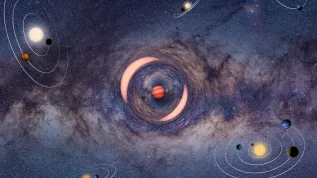
Comets, like other objects in space, rotate around their own axis. Researchers speculate that sometimes their rotation speed increases dangerously, and the comet shatters into pieces and dies, swirling to death. Polish scientist studies this type of comet suicide in order to determine the natural life of these objects. He conducts his observations using the Hubble Space Telescope.
Although from the moment of their formation comets remain at very low temperatures on the outskirts of the Solar System, from time to time they appear in the vicinity of the Sun, which is how we can observe them from Earth. Laymen associate them primarily with the tail, which they leave when traversing the sky. They are believed to have accompanied important events in the history of mankind. For scientists they constitute extremely valuable material for research.
"It is believed that comets could have brought water and organic compounds to Earth when the planet was still very young. We call them time capsules, because the matter of which they are composed, basically has not changed since their formation at the very beginning of the existence of the Solar System. Research into the composition of comet matter may tell us a lot about the original material from which the Sun, Earth and other planets formed" - told PAP Dr. Michał Drahus from the Jagiellonian University.
Polish researcher is interested in slightly different aspect of the life of comets. In a project funded by the National Science Centre, he studies the natural life of these objects and the moment of their death. "I would like to find out how comets end their life, and how long they can survive" - he explained.
If scientists could determine the life time of comets, it would be possible - according to Dr. Drahus - to more accurately determine, for example, the original number of comets that had formed at the dawn of the Solar System. It would also be possible to better estimate the frequency of their collisions with the "young Earth", and thus the efficiency of delivering water and organic compounds to the planet.
There are many dangers that threaten a comet\'s life. It can, for example, disintegrate as a result of a collision with another celestial body. However, one of the most common causes of comet death is probably so called rotary disintegration. "It occurs when a celestial body rotates around its own axis so fast that it is torn to pieces by this rapid rotation. Such disintegration decay is the death of a comet, and it is a suicidal death. We are trying to determine if this is how comets\' life usually ends" - explained the researcher.
The biggest threat to comets is their own matter - the same matter that creates spectacular tails. Flowing from the comet\'s nucleus, it generates force like a jet engine, which can fatally accelerate the rotation. The condition, however, is the small size of the comet, because the more massive comets are not easy to spin up.
"Since the mid-nineteenth century, we have known examples of comets, and for several years also an asteroid that literally break down before our eyes. The main problem with testing hypotheses about the death as a result of rotary disintegration, however, was that we did not know the rotation speed of any of these bodies. We were missing the key piece of the puzzle" - said Dr. Drahus.
A team of researchers led by Dr. Drahus recently broke the deadlock, determining for the first time the rotation speed of one of the small bodies in the Solar System, which recently fell apart. There are many indications that the study object number P/2012 F5 is not a comet, but a planetoid. "From the point of view of our research this does not matter" - said the astronomer. It turned out that the rotation speed of the object was very high, because one rotation around its axis takes a little over three hours. The researchers also identified four smaller fragments that broke away from it. "This is the strongest evidence to date of rotary disintegration, but it can not yet be considered a hundred percent proof" - noted Dr. Drahus.
Scientists made their discovery and measured the rate of rotation of the object while working on the Keck II telescope in Hawaii - one of the best ground-based telescopes. However, they conducted further studies - winter 2015/2016 - using one of the most famous research tools in the world - the Hubble Space Telescope. "Hubble is the most perfected and most expensive telescope made by man. Its value is comparable to the value of the Large Hadron Collider" - noted the researcher.
But this is not the end of their work. As the first results obtained with the Hubble Space Telescope have exceeded their wildest expectations, NASA has assigned them extra time for observations, among others, from the pool of the observatory director. "NASA has also granted us observation time from the normal pool, but at once in two consecutive Hubble Space Telescope cycles, in 2017 and 2018, which happens very rarely. Usually, programs are selected for execution in the next cycle of the telescope . Together with the time that we have already used, we got 30 orbits for our research. That is a lot, especially since competition on the Hubble Space Telescope is huge" - said Dr. Drahus.
As he pointed out, this was the first time NASA awarded the precious observing time on the Hubble for a study led by a scientist from Poland. The observations, in which Dr. Wacław Waniak from the Jagiellonian University is also involved, could allow Polish researchers to finally confirm whether the breakdown of P/2012 F5 was rotary or not.
PAP - Science and Scholarship in Poland, Ewelina Krajczyńska
ekr/ agt/ mrt/
tr. RL













